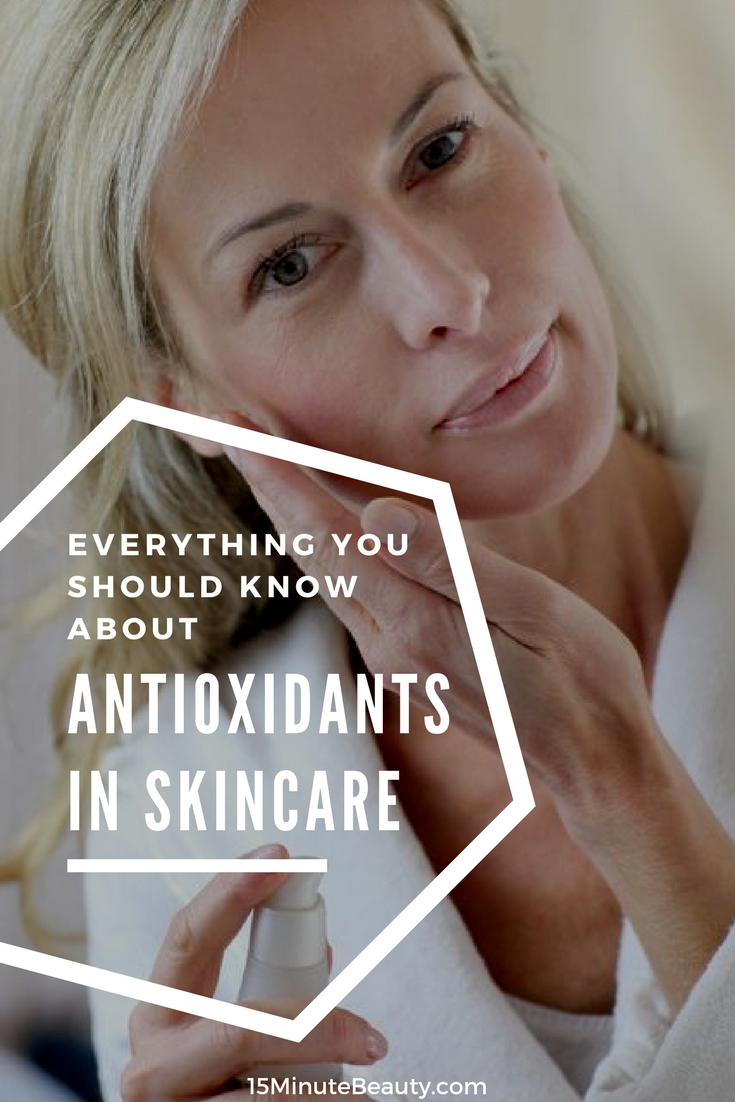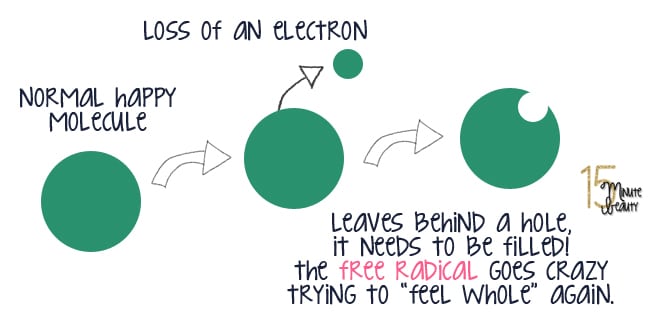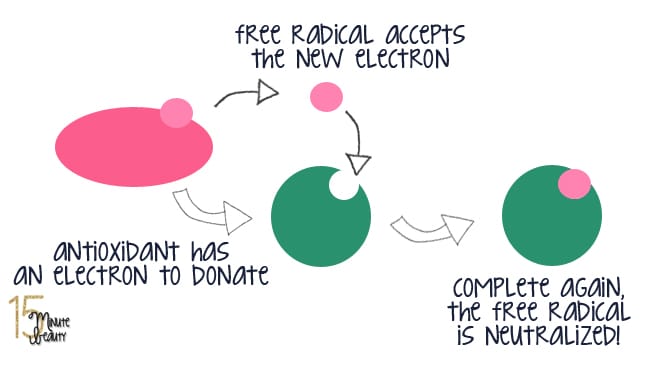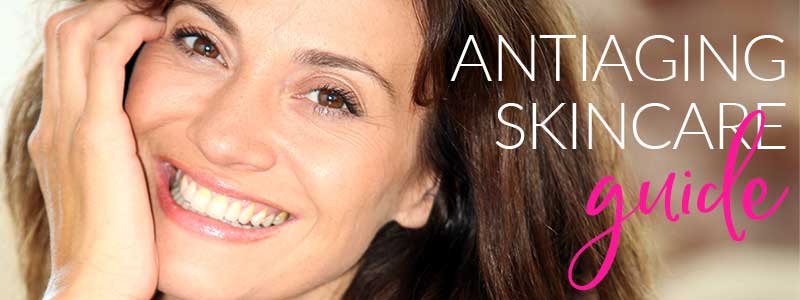Much has been made in the lay press (meaning, ABC News and such), beauty mags, on-line, pretty much everywhere you look about antioxidants. They are reported to not only fix your skin, but will make it so that you never get cancer and live 20 years longer. Now, while I don’t know for sure about any of those three (I’m pretty sure no one knows, actually), but dermatologists are pretty sure that antioxidants do help with aging, and there are plenty of studies on going right now. (Note that the only topical product shown to improve wrinkles is Retin-A.)
Well, what exactly is an antioxidant? It’s something that fights free radicals. I think that it was explained best by Alton Brown of all people, who is a chef on the Food Network that my brother is obsessed with! (Really, he has severe food allergies so he does all of his own cooking. He has hundreds of Alton’s episodes on tape and my little brother frequently cooks things like duck! Who knew a guy who can’t match his clothes could do that? Amazing!)
Basically, the free radicals are created when they give up or lose an electron. That lose leaves a hole, and the newly created free radical doesn’t know how to cope with this. It goes crazy trying to fix that hole, which means in your skin the free radical bounces around in skin cells, causing damage to things like your cell membrane or even your DNA, attempting to fix that hole.
So, now that you know what a free radical is, how are they created? Pretty much anything that challenges the skin.
•UV Rays (Sunlight)
•Drugs
•Pollution
•Heat
•Cold
Antioxidants help to control the free radical damage by getting rid of the free radicals. They can donate an extra electron to the free radical, filling that hole and fixing the behavior. The free radical no longer goes around causing damage.
The skin does have it’s own antioxidant system to help to counteract these free radicals, however over time the free radicals can continue to damage cells and their DNA. In addition, your body’s antioxidants decrease with age, leaving the free radicals unchecked, and leaving your cells, cell membranes and DNA more vulnerable to damage. This results in loss of firmness, radiance, elasticity and can contribute over time to aging of the skin. Notice that I said over time. Because in theory you’re experiencing this type of damage all the time, though more so after exposures to sun and such. But, the damage is cumulative and although you won’t be able to see results right away, chances are you will see them in the long term. I think of this as similar to wearing sunscreen. You might not see a big difference now, but if you compare yourself to your friends that didn’t do it in 10 years, you’ll likely see a difference.
A huge number of antioxidants are on the market right now, here’s a quick overview of a few of them. Note that some of these are applied topically, but some can also be taken orally. Is one better than the other? We’re not sure. But, since most of these are simply vitamins, I think you probably couldn’t go wrong with improving your diet and using a product with an antioxidant in it.
Now, this is the boring part of the post where I list a bunch of ingredients and quote a little bit of stuff from some reviews I’ve found on-line and then researched a bit on my own to make sure stuff was accurate. I’m by no means an expert on antioxidants (especially since there are so many of them), but here’s some info on the ones you’re most likely to run in to.
Allantoin
Long used to help protect the skin in creams and lotion, allantoin was thought to be a skin protectant. It has been called a “cell proliferant, epithelization stimulant, and a chemical debrider.” Basically, it helps to exfoliate and stimulate new skin growth.
Alpha Lipoic Acid (ALA)
ALA is unique, as it is soluble in both water and lipids, so it easily penetrates into the skin. It seems to help protects Vitamins E and C, helping to boost their activity within the cell by “reenergizing” them. It is also converted in the skin into another chemical that has it’s own antioxidant properties.
Copper Peptides
Copper has long been known to be important in the creation of collagen and elastin (again, important parts of the dermis), both of which are decreased with aging. Copper does have a bit more research than many other topical antioxidants, and some well design (aka- double-blind placebo controlled) research studies have shown improvement in fine wrinkles, hyperpigmentation and decreased photodamage. Copper increases the body’s superoxide dismutase levels (see below). They even found a 17.8% improvement in skin thickness! Overall that does sound great, and copper is very appealing to add to products since it is non-irritating and pretty cheap to add to creams.
Dimethylaminoethanol (DMAE)
When used topically, DMAE has been found to increase firmness of the skin, likely because it helps to reduce some linking between proteins in the skin that happens with aging, as well as separate antioxidant properties.
Glutathione
Composed of glutamic acid, cysteine, and glycine, this little protein is found in all animal tissues, is one of your body’s main antioxidants and is very decreased in the skin after skin exposure.
Grape and Grape Seed Extract
Proanthocyanidin, a very powerful antioxidant is found in grapes and grape seed extracts. While this antioxidant doesn’t have strong evidence that it works topically (really, most of these things I’m listing don’t have much evidence anyways), it was found to have strong effects on free radical damage of fat cells especially, as well as improved wound healing and prevention of tumors (both in mice).
Green Tea
Green Tea has some great things in it call polyphenols and they have been widely reported to be the strongest antioxidant you can get. When mice drink them, there are marked changes in the enzymes in their skin, making serious changes in the way the skin reacts to the sun. Just knowing that makes me want to drink only green tea for the rest of my life, but there’s a lot more! Even without UV radiation there are polyphenols that induce expression of enzymes to help fight free radical damage. In tissue culture fibroblasts in the dermis either decrease or delay changes they show with age. DNA damage from free radicals is dramatically reduced in the setting of Green Tea Polyphenols.
Melatonin
Yup, that stuff you take to help prevent jet lag is an antioxidant! It’s released by the brain, and it’s able to both act as an antioxidant, increase the activity of other antioxidants and to help decrease redness from sunburn. Oh, and help you reset your internal clock, but I’m not going to go into that!
Panthenol
An alcohol derivative of Vitamin B5, Panthenol is actually a humectant (see, it’s here in my moisturizer guide), and is very easily found in moisturizer, shampoo, conditioner, etc. Once it’s in the skin, it get converted to an acid that is an important cofactor for Coenzyme A, allowing your skin to function normallly. It’s pretty stable, but doesn’t do well in acidic or basic environments or high heat.
Soy Isoflavones
Only available orally, Genistein and Daidzein help to enhance the antioxidants your body already makes. Mice were fed a solution with these 2 isoflavins, and for weeks afterwards their skin had decreased roughness and improved collagen levels after sun exposure. Does this mean that if you eat soy it will make your skin smoother? Not quickly, but it may help in the long run.
Spin traps
Spin traps are kinda cool, they react with the free radicals to create unreactive free radicals, so they can’t cause any damage! They are very powerful though typically expensive. You can find them in products like Your Best Face skin care.
Superoxide dismutase (SOD)
An enzyme that destroy a very active reactive oxygen species (super oxide), this is a very big enzyme and it has a really hard time penetrating into your skin. This makes it very difficult to use as a topical agent. If it could get there, it would be very useful and would dramatically decrease redness from sunburn as well as the damage from the UV exposure.
Ubiquinone (Coenzyme Q)
This one likely sounds very familiar, as it can be found in a huge number of products on the market right now. This chemical works within the cell’s mitochondria (a little energy creating organ found within each cell) to help create energy and it helps to reduce damage of certain proteins even better than vitamin E.
Vitamin A
Vitamin A was the first antioxidant to be used for anti-aging, and it’s synthetic derivatives (the retinoids) are even more useful given their stability. Retinoids are the only agents that have been found to be effective against wrinkles in studies and are the gold standard.
Vitamin C
Also known as L-ascorbic acid, Vitamin C is that thing that gives you scurvy if you’re deficient. It’s water soluble and works in the early stages of production for collagen (it even helps to stimulate collagen production) and a few amino acids. Vitamin C has even been found to be low in the skin after sun exposure. Very few studies on Vitamin C in the setting of photodamage or in humans (rather than in petri dishes) have actually been completed. Vitamin C is easily degraded by both heat and light, which means that is is hard to include in topical formulations since it easily breaks down.
You can read more about Vitamin C in skincare here.
Vitamin E
Alpha-tocopherol is found in membranes and tissues galore, and in fact the term “Vitamin E” actually refers to 8 different molecules that have the same activities. It is lipophilic, meaning it likes being around fats, so it’s really great at hanging around the membranes of cells and protecting them from destruction/damage. Studies have shown that when applied before sun exposure, you’ll have less redness, swelling, DNA damage and sunburn. However, you probably should be avoiding the sunburn by use of sunscreen, rather than just putting on Vitamin E before you go out!
There are important things to remember about antioxidant use to fight aging.
1. It has not been proved clinically, even though it seems logical that antioxidants would help fight signs of aging.
2. Any effects you will see are likely to occur over a long period of time.
3. If you’re going to use antioxidants on the skin, the formulation must be stable (meaning the antioxidant doesn’t break down and become useless), must be a high enough concentration and must not only get to the target area but must stay there long enough to work.
Check out more anti-aging skincare information and reviews in my guide!





 I’m a doctor, a mommy and a bit of a beauty addict. If you let me, I can take 2 hours to get ready in the morning. Really. I'm on a quest for faster beauty that works!
I’m a doctor, a mommy and a bit of a beauty addict. If you let me, I can take 2 hours to get ready in the morning. Really. I'm on a quest for faster beauty that works!
Take a look at adding stabilized rice bran like ‘riceplex’ to your diet. It is nutrient-dense, so you get a lot of nutrition with relatively few calories, and it is very high in antioxidants.
In defense of myself for my non-matching clothes I’ll point out I’m mostly color blind. My sister has her looks, I’ve got my food. As it happens the duck recipe that I usually use is both from Alton Brown (Who I do like but he’s not my primary recipe source) and it uses pineapple orange juice which is at least semi-pertinent. Though I wouldn’t know how well vitamin C lasts through cooking.
Mighty Duck is the recipe and it’s really very easy to make and strongly recommended.
-The Little Brother,
Greg
I just started back up on my vitamin regimen to see if I can see any improvement in my skin and hair. It’s only been a week, so it’s too soon to tell! I also use topical antioxidants, but since they are more prevention than anything, it’s hard to know if they are working to fight the free radicals!
I take OPC and it is packed with anti-aging ingredients – grape seed extract being one of them. Thanks for the tip.
Your article make some great points and would have to agree with it. I have been taking a supplement and it does a lot of what your articles talks about in free radicals and has one called glutathione. It help your body reproduce glutathione and my wife and I have both taken it and noticed our skin feels better. If you want learn about the product go to http://www.learnaboutmaxgxl.com/products.
Great post I think I will have to look into this a bit further.
Such a great information and I've been looking for this..